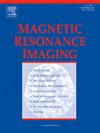透明细胞肾细胞癌WHO/ISUP分级的预测:来自酰胺质子转移加权MRI的见解。
IF 2.1
4区 医学
Q2 RADIOLOGY, NUCLEAR MEDICINE & MEDICAL IMAGING
引用次数: 0
摘要
背景:透明细胞肾细胞癌(ccRCC)分级的术前预测可以支持手术切除策略的最佳选择。目前,还没有有效的术前方法来准确评估ccRCC的组织学分级。需要更精确、非侵入性的预测方法。目的:探讨酰胺质子转移加权(APTw) MRI对ccRCC病理性分级的预测参数,以及APTw、弥散加权成像(DWI)和mDixon MRI技术联合应用是否能提高预测效果。材料和方法:本前瞻性研究纳入了2021年3月至2024年6月期间接受多参数MRI检查(包括APTw、DWI和mDixon)以及对比增强CT或MRI检查的ccRCC患者。测量实体瘤部分APTw和表观扩散系数(ADC)成像的平均值、最大值、最小值和标准差(SD)值以及mDixon成像的脂肪分数(FF)值。计算参数的受者工作特征曲线下面积(AUC)值,以评估诊断性能。结果:共48例ccRCC患者(平均年龄65 岁;男性32例,其中重度ccRCC 10例,轻度ccRCC 38例。与低级别ccRCC相比,高级别ccRCC表现出更高的APTwmean(2.28 % vs. 4.17 %;P max(4.97 % vs. 8.48 %; P 最小值(1.23× 三分 平方毫米/秒和0.94 × 三分 平方毫米/秒;P 均值、APTwmax、APTwSD、ADCmin及这些因素联合区分低分级和高分级ccRCC分别为0.728、0.786、0.832、0.741、0.858。结论:APTwmean、APTwmax、APTwSD、ADCmin值是预测ccRCC术前病理分级的潜在指标。APTw参数单独使用或与其他参数结合使用都具有一定的优势。本文章由计算机程序翻译,如有差异,请以英文原文为准。
Prognosticating WHO/ISUP grade in clear cell renal cell carcinoma: Insights from amide proton transfer-weighted MRI
Background
Preoperative prediction of clear cell renal cell carcinoma (ccRCC) grade can support optimal selection of surgical resection strategies. Currently, there is no effective preoperative method for accurately assessing the histologic grade of ccRCC. More precise, non-invasive prediction methods are needed.
Purpose
To investigate the parameter of amide proton transfer-weighted (APTw) MRI for prediction of pathological ccRCC grade and whether the combination of the APTw, Diffusion-Weighted Imaging (DWI), and mDixon MRI techniques can improve the prediction performance.
Materials and methods
This prospective study included ccRCC patients who underwent multiparametric MRI examinations (including APTw, DWI, and mDixon) along with contrast-enhanced CT or MRI examinations from March 2021 to June 2024. The mean, maximum, minimum, and standard deviation (SD) values from APTw and apparent diffusion coefficient (ADC) imaging of the solid tumor portions and the fat fraction (FF) values from mDixon imaging were measured. The area under the receiver operating characteristic curve (AUC) values for the parameters were calculated to evaluate the diagnostic performance.
Results
A total of 48 ccRCC patients (mean age, 65 years; 32 males) were included, of whom 10 had high-grade ccRCC and 38 had low-grade ccRCC. Compared with low-grade ccRCC, high-grade ccRCC exhibited higher APTwmean (2.28 % vs. 4.17 %; P < .05), APTwmax (4.97 % vs. 8.48 %; P < .01), and APTwSD (1.10 vs. 1.75; P < .01) values as well as lower ADCmin values (1.23 × 10−3 mm2/s vs. 0.94 × 10−3 mm2/s; P < .05). The AUC values for the ability of APTwmean, APTwmax, APTwSD, ADCmin, and these factors combined to distinguish between low-grade and high-grade ccRCC were 0.728, 0.786, 0.832, 0.741, and 0.858, respectively.
Conclusion
APTwmean, APTwmax, APTwSD, and ADCmin values are potential indicators for preoperative prediction of ccRCC pathologic grade. APTw parameters offer certain advantages for use alone or in combination with other parameters.
求助全文
通过发布文献求助,成功后即可免费获取论文全文。
去求助
来源期刊

Magnetic resonance imaging
医学-核医学
CiteScore
4.70
自引率
4.00%
发文量
194
审稿时长
83 days
期刊介绍:
Magnetic Resonance Imaging (MRI) is the first international multidisciplinary journal encompassing physical, life, and clinical science investigations as they relate to the development and use of magnetic resonance imaging. MRI is dedicated to both basic research, technological innovation and applications, providing a single forum for communication among radiologists, physicists, chemists, biochemists, biologists, engineers, internists, pathologists, physiologists, computer scientists, and mathematicians.
 求助内容:
求助内容: 应助结果提醒方式:
应助结果提醒方式:


